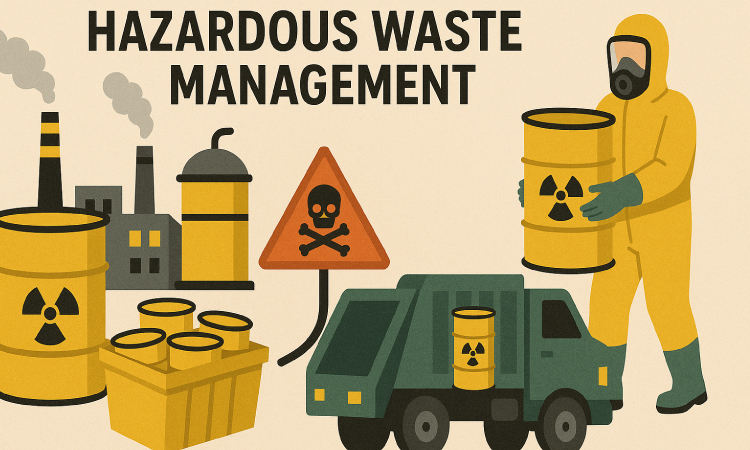Hazardous Waste Management

Hazardous waste management is a critical component of environmental protection and public health strategy across the globe. As industries grow and technologies evolve, the generation of hazardous waste has become inevitable. This category of waste, which includes toxic, reactive, corrosive, and ignitable materials, poses significant risks if not managed properly. Effective hazardous waste management ensures the safe handling, storage, treatment, and disposal of these materials, mitigating their harmful impact on human health and the environment
Defining Hazardous Waste
Hazardous waste is any waste material that is dangerous or potentially harmful to human health or the environment. This includes a wide range of substances from industrial processes, laboratories, hospitals, and households. Common examples are chemical solvents, batteries, pesticides, medical waste, and electronic waste. Hazardous waste is typically categorized by characteristics such as toxicity, reactivity, flammability, and corrosivity.
The identification and classification of hazardous waste are governed by regulatory frameworks established by bodies such as the Environmental Protection Agency (EPA) in the United States and similar organizations worldwide. These regulations provide detailed criteria for determining whether a substance qualifies as hazardous and dictate the appropriate management protocols.
Sources of Hazardous Waste
Hazardous waste originates from a variety of sources. Major contributors include:
1. Industrial Activities: Manufacturing processes in chemical, pharmaceutical, textile, and electronics industries generate large volumes of hazardous by-products.
2. Healthcare Facilities: Hospitals and clinics produce medical waste such as contaminated sharps, expired pharmaceuticals, and biohazardous materials.
3. Agriculture: Pesticides, herbicides, and veterinary pharmaceuticals contribute significantly to hazardous waste in the agricultural sector.
4. Households: Everyday items like cleaning agents, batteries, paints, and electronics are sources of household hazardous waste (HHW).
The Lifecycle of Hazardous Waste Management
Hazardous waste management involves several interconnected stages:
1. Generation and Identification: The process begins with the identification of hazardous waste at the source. Proper labelling and documentation are vital for subsequent handling.
2. Collection and Storage: Waste is collected and temporarily stored in secure containers designed to prevent leaks, spills, or reactions. Facilities must adhere to strict safety standards.
3. Transportation: Licensed carriers transport hazardous waste to treatment or disposal facilities. This step requires careful planning to prevent accidents during transit.
4. Treatment: Treatment processes vary depending on the type of waste. Common methods include incineration, chemical neutralization, and solidification. These methods aim to reduce toxicity, volume, or both.
5. Disposal: Final disposal methods include secure landfilling and deep-well injection. These facilities are engineered to contain waste safely and monitor environmental impacts over time.
6. Monitoring and Compliance: Continuous monitoring ensures that hazardous waste management practices comply with legal standards and do not pose long-term risks.
Regulatory Framework and Compliance
Robust regulatory frameworks are essential for effective hazardous waste management. Key international and national regulations include:
- The Resource Conservation and Recovery Act in the U.S. governs the generation, transportation, treatment, and disposal of hazardous waste.
- The Basel Convention restricts the transboundary movement of hazardous waste to protect developing countries from unsafe dumping.
- EU Waste Framework Directive sets comprehensive waste management requirements across European Union member states.
Regulatory compliance enforced through permits, inspections, and penalties for violations. Companies required to maintain meticulous records, submit periodic reports, and implement emergency response plans.
Challenges in Hazardous Waste Management
Despite advancements, several challenges persist:
- Illegal Dumping: Improper disposal to avoid costs or circumvent regulations is a significant issue, particularly in developing regions.
- Limited Treatment Facilities: Inadequate infrastructure for treatment and disposal hinders effective management.
- Public Awareness: Lack of awareness among the public and small businesses leads to improper disposal of hazardous materials.
- Evolving Waste Streams: Emerging technologies and materials (e.g., nanomaterials, e-waste) complicate waste classification and treatment.
Innovative Solutions and Best Practices
To overcome these challenges, several innovative practices and technologies are being adopted:
- Green Chemistry: Designing products and processes that minimize or eliminate hazardous substances at the source.
- Integrated Waste Management Systems: Combining physical, chemical, and biological treatment methods to improve efficiency and reduce environmental impact.
- Digital Tracking Systems: Using GPS and blockchain technology for real-time monitoring of hazardous waste movements.
- Public Education Campaigns: Raising awareness through outreach programs and incentivizing proper disposal behaviours.
Conclusion
Hazardous waste management is a dynamic field that demands a multidisciplinary approach, encompassing science, engineering, policy, and community engagement. As the volume and complexity of hazardous waste continue to grow, there is an urgent need for more robust systems, innovative technologies, and stricter enforcement. Sustainable hazardous waste management not only protects human health and ecosystems but also contributes to the broader goals of environmental stewardship and sustainable development. Governments, industries, and citizens all have a role to play in ensuring that hazardous materials are managed responsibly and safely.
| To use our services right now, you can call us at +91-9812241001 or send us an email at info@kelvinindia.in We will be delighted to assist you! |